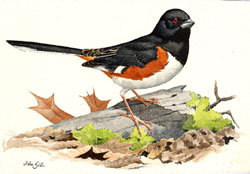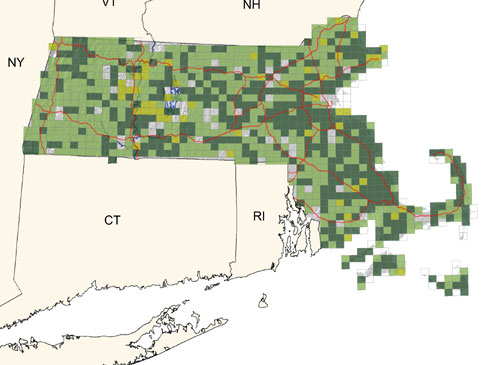Breeding Bird Atlases (BBA)
Find a Bird - BBA1
Breeding Bird Atlas 1 Species Accounts
Eastern Towhee
Pipilo erythrophthalmus
Egg Dates
May 11 to June 23
Number of Broods
one or two

The bustling and energetic, yet often secretive, Eastern Towhee is one of the most common and widely distributed breeding birds in the state, but it is most abundant in the brushy areas of the southeastern region, particularly Cape Cod and the Islands. Although it occupies a variety of habitats, ranging from open forest and woodland edges to overgrown fields and power-line cuts, it is most at home in dense thickets and undergrowth. This ground feeder is often first noticed because of its characteristic noisy raking of the ground litter while foraging. The species was described in the early literature as “an exemplary woodland citizen” because of its diet of “harmful insects.” Towhees also feed on other invertebrates, seeds, and small fruits.
Towhees are seldom seen in any numbers during the spring migration. Adult males return first in late April and early May and make their presence known by singing on or near the territory held the year before. Females and yearling males have settled in by mid-May. Towhees sing with vigor during spring and early summer and have quite a varied repertoire. The song is described as drink-your, teeeee or sweet-bird, cheeeee, sometimes shortened to your-teee. The first note is on a high pitch, and the song ends in a trill. Females also sing on occasion. The call note, quite important in the poor visibility conditions of their habitat, is a che-’wink or tow-’whee. Towhees are fairly quiet after the breeding season, and often the call note or the feeding kick noises are the best clues to their presence in late summer or fall.
Courtship activity includes singing sometimes very muted songs, and noticeable short-flight chasing of the female by the male. During such pursuits, the male frequently flashes the white outer tail feathers by fanning his tail. The nest is located on the ground or at low heights in vines and bushes and is made of grasses or woven leaves, sometimes lined with hairs. Males may present nesting material to their mates but do not perform any of the actual nest construction. Habitats for 16 Massachusetts nests were woods (8 nests), old field (3 nests), brush (2 nests), hedgerow (1 nest), old orchard (1 nest), and dune thicket (1 nest) (CNR). Locations for 22 state nests were the following: ground (21 nests), ranging from sites in sand and pine needles, clumps of Poison Ivy, False Solomon’s Seal, Lowbush Blueberry, and grass to dense brush. One nest was 2 feet up in a bush (CNR, Meservey).
Clutch sizes for 27 state nests were one egg (1 nest, probably an incomplete clutch), two eggs (2 nests, probably also incomplete), three eggs (4 nests), four eggs (17 nests), five eggs (2 nests), six eggs (1 nest) (CNR, Kroodsma, DKW, Meservey). Incubation lasts for 12 to 13 days, and the young remain in the nest for 10 to 12 days. The male participates fully in the feeding of the young but does not assist in incubating or brooding. Nestlings have been reported in the state from May 31 to June 17 (CNR, Kroodsma), although later dates are to be expected, and fledglings have been observed from June 11 to August 18 (CNR, Meservey). Brood sizes for 17 Massachusetts nests were two young (2 nests), three young (8 nests), four young (6 nests), five young (1 nest) (CNR, Kroodsma, Meservey). One known state hatch date was June 11 (CNR). Outcomes for 15 sample state nests were young fledged (3 nests), unknown (3 nests), failure (9 nests) (CNR). Renesting usually occurs in the same territory, with the first egg of the second clutch deposited 10 to 20 days after the young of the first brood fledge. Juvenile birds have a streaked plumage, but they resemble the adults after a molt in late summer.
The peak of towhee fall migration is from mid-September to mid-October, and loose flocks of 8 to 12 birds are not uncommonly found in coastal thickets. Lingerers continue into November, and, occasionally, considerable numbers attempt to overwinter, especially in milder coastal regions. Towhees winter from Maryland and Virginia to Florida.

Note: common in brushy second growth and open woodlands; very common on the Cape and Islands; declining
Arnold K. Brown



